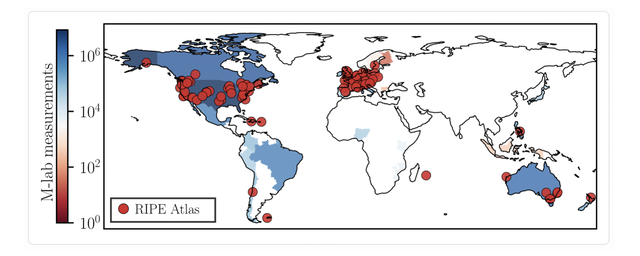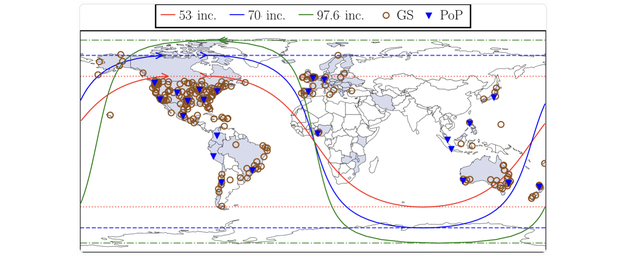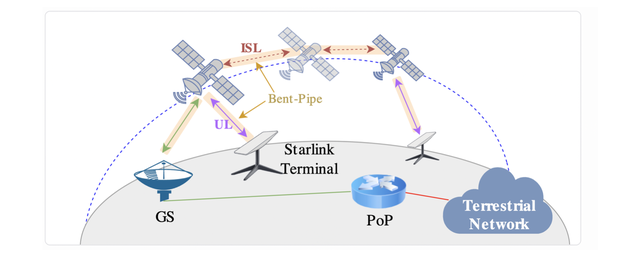How does Starlink stack up against terrestrial ISPs as a global service? And exactly what factors impact its operations? A new multifaceted active and passive measurement study uncovers the good, the bad and the ugly when it comes to Starlink performance.
Communicating using orbiting satellites is nothing new: the first satellites designed with communication in mind launched in the late 1950s and the idea had been proposed over a decade beforehand. However, a seismic change occurred in the last 5 years when spacecraft manufacturer and launch provider SpaceX announced their intention to launch and operate a satellite Internet service, Starlink.
As of today, Starlink is the world's largest satellite constellation, consisting of over six thousand satellites, with another six thousand planned. The sheer scale of this constellation enables Starlink to have sufficient capacity and coverage to offer global, high-speed connectivity.
By offering both global and high-capacity connectivity, Starlink is the first non-terrestrial network that is a credible competitor to existing terrestrial competitors. Moreover, with satellites covering the entire Earth, Starlink has the capability to bridge connectivity gaps within remote regions and position itself as a “global ISP.”

To understand the global performance of Starlink and what factors impact its operations, we conducted a thorough multifaceted active and passive measurement study, which was published in the Proceedings of the ACM on Web Conference 2024.
This post summarises the key learnings from our extensive measurement study which explored (i) global network performance through M-Lab and RIPE Atlas measurements (resulting in almost 20 million measurements from 34 countries, shown in fig. 1), (ii) real-time Zoom and cloud gaming applications, and (iii) internal operations of the Starlink network through controlled measurements.
Starlink Network Operations: A Primer

Starlink satellites revolve around the Earth in fixed orbital shells which are described by their inclination angle to the equator. The majority of Starlink's operational 4,000 satellites lie within the 53° shell, which only covers parts of the globe (see fig. 2). The 70° and 97.6° orbits allow serving regions near the poles. These other shells however have fewer satellites.
In addition to the constellation of orbiting satellites in space, Starlink network operation hinges on several essential terrestrial components. Figure 3 shows a cross-section of the Starlink network. End-users connect to the Internet with a user terminal, affectionately called a “Dishy”, that communicates with satellites visible above the 25-degree elevation using an phased-array of Ku-band antennas. At the other end are Starlink ground stations, communicating over the Ka-band. These ground stations are connected over a private network to a point-of-presence, which enables traffic to route to the Internet.

The Dishy to satellite to ground station link forms a “bent pipe architecture”, and requires that both the Dishy and ground station lie within the coverage zone of the satellite (approximately 1000 km) providing the “bent pipe” route. Figure 2 shows the geographic deployment of Starlink ground stations and PoPs, which highlights that a bent-pipe connection is not always possible, especially in remote regions of Africa and South America. To combat this, recent generations of Starlink satellites are equipped with laser-based communications to enable inter-satellite links (ISLs) that can form “extended” bent-pipe and connect users to farther ground stations.
The Good

A key finding of our study is that Starlink provides a global service that is competitive to terrestrial ISPs. In several places, particularly in the US, Starlink is providing a service that is comparable, performance-wise, to terrestrial providers. Looking beyond the US, although Starlink typically performs slightly poorer than existing terrestrial providers, the difference is often marginal and rarely drops below an acceptable level of service.
Zooming in to specific applications, we found that Starlink remains competitive with terrestrial fibre and cellular ISPs for demanding real-time applications of video calling (Zoom) and cloud gaming (Amazon Luna). Both of these applications require low-latency and high-bandwidth; they differ in that cloud gaming performance largely depends upon round-trip latency and downlink bandwidth, while for video calling both uplink and downlink bandwidth play an important role. Our study found that the performance was largely equal between terrestrial (fibre and cellular) and Starlink, although for cloud gaming Starlink exhibited better performance than cellular 5G.

Looking instead at a specific geographical region, we conducted a case study focusing on Reunion Island, located in the Indian Ocean. The island receives terrestrial connectivity through two submarine-laid cables, routing traffic to either Asia or South America. Although Starlink does not host any ground-based infrastructure in Reunion Island, the round-trip latencies experienced by Starlink customers is lower than that of the terrestrial service, thanks to Starlink’s ability to route traffic directly between satellites using ISLs to associated PoP in Germany located ~9000 km away. This case study demonstrates Starlinks ability to connect remote regions with a quality of service higher than that of current terrestrial offerings.
The Bad

However, despite these positive findings our study also uncovered that there can be significant performance degradation for Starlink subscribers in specific geographical locations.
Taking Europe as an example, we found that Dublin, London and Berlin exhibit comparable latencies to the US, while for Rome and Paris the latencies are larger. We hypothesise that these differences are due to the varying densities of the supporting Starlink ground infrastructure, specifically the "Point of Presences" (PoPs) that act as the gateway for all local Starlink traffic to reach the Internet. This hypothesis was validated through a longitudinal case study of the Philippines, where we observed the impact of the deployment of a new PoP in May 2023 (see fig. 7). Before the PoP was locally deployed in-country, Philippines-based users accessing local services observed high latencies as the Starlink traffic was received by ground station in Philippines but was then routed to the nearest PoP in Japan via undersea cable, travelling back to the Philippines to the local server. After PoP deployment in the Phillipines, this non-optimal terrestrial routing route was cut short and latencies noticeably improved.

While we noted above that trends suggest SpaceX is prioritising stable global performance, this finding reveals that non-terrestrial networks such as Starlink are not a silver bullet to allow ISPs to avoid costly investments in ground infrastructure. Such investments are necessary, albeit at a lesser scale, with non-terrestrial networks in order to ensure acceptable and consistent performance. Furthermore, investment is also required in the non-terrestrial infrastructure, i.e. the satellites. We additionally observe performance degradation for users at high latitudes due to the smaller number of satellites that are able to serve these users.
The Ugly
While the performance issues described above can be mitigated through investment in both the ground and space infrastructure, our study also uncovered a source of performance fluctuations that is integral to the scheduling system used by Starlink, and therefore is far more deeply rooted and fundamental to the network design. The scheduling system relies upon 15 second reconfiguration intervals that enable the connectivity scheduled for each user to be updated and modified in fixed 15 second allocations.

Fine-grained measurements revealed that the reconfiguration intervals have an observable effect, particularly at the boundary between intervals. At this boundary we observed significant shifts in round-trip latency, and substantial (if momentary) drops in available bandwidth. The general understanding within the community is that Starlink performs satellite handovers at these fixed 15 second intervals, which is the primary cause of performance degradation. However, in our targeted experiments where we shielded a Starlink dish to only connect to sparse 72 degree and 97.6 degree inclination orbits we observed similar performance fluctuations at reconfiguration boundary interval even when the dish remains connected to the same satellite.

We also found these fluctuations have a tangible impact on the application performance of Starlink. Revisiting our experiments with Zoom and Amazon Luna, we observed corresponding fluctuations in their performance. The former experienced shifts in the one-way-delay while the latter experienced occasional drops in the frame rate, both of these anomalies coinciding with the boundary between reconfiguration intervals. Perhaps more significantly, we noticed changes in the amount of error correction packets being sent, and again these changes aligned with the interval boundaries.
Concluding Thoughts
We set out to understand if Starlink was a viable competitor to terrestrial ISPs and found that it is a competitive and rapidly maturing network. However, non-terrestrial networks are not a silver bullet: network investment, both in satellites but also (and perhaps overlooked) in terrestrial infrastructure, are key to ensuring a performant network. We further uncover that the peculiarities of the internal network scheduling and management used by SpaceX introduce anomalies into the performance, a factor that must be addressed by the transport or application layers.
Check out the full paper published in ACM The Web Conference (WWW) 2024 here. Feel free to also play around with the associated fully open-sourced dataset and code. Paper authors: Nitinder Mohan, Andrew E. Fergusson, Hendrik Cech, Rohan Bose, Prakita Rayyan Renatin, Mahesh K. Marina, Jörg Ott.
This blog article was jointly authored with Andrew Ferguson, who is a Ph.D. student in the School of Informatics at the University of Edinburgh, UK.




Comments 0
The comments section is closed for articles published more than a year ago. If you'd like to inform us of any issues, please contact us.